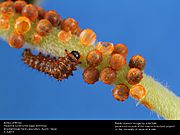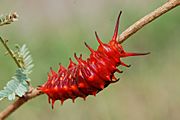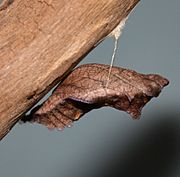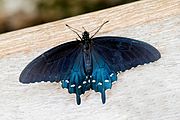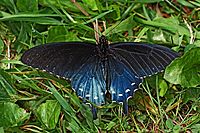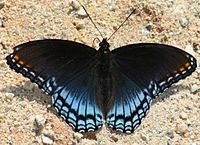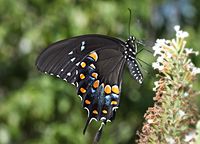Pipevine swallowtail facts for kids
Quick facts for kids Pipevine swallowtail |
|
|---|---|
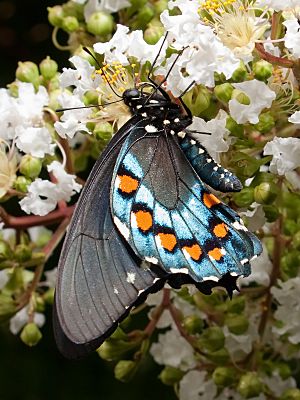 |
|
| Conservation status | |
| Scientific classification | |
| Subspecies | |
|
See text |
The Battus philenor, also known as the pipevine swallowtail or blue swallowtail, is a beautiful swallowtail butterfly. You can find these butterflies in North America and Central America. They are mostly black with shiny, iridescent-blue colors on their back wings.
Pipevine swallowtails live in many different places, but they especially like forests. Their caterpillars are often black or red. They eat special plants from the Aristolochia family. These caterpillars are clever! They take acids from the plants they eat. This makes them taste bad or even poisonous to animals that might try to eat them. Adult butterflies drink nectar from many kinds of flowers. Some tropical Aristolochia plants can actually be harmful to the caterpillars. People on the West Coast have tried to help these butterflies. In Michigan, the pipevine swallowtail is a butterfly of "Special Concern."
Contents
What's in a Name?
The pipevine swallowtail was first named in 1771 by a scientist named Linnaeus. He first put it in the Papilio group. Later, in 1777, another scientist named Scopoli moved it to the Battus group.
Why the Name "Battus"?
The name Battus comes from an old Greek leader named Battus I. The second part of its name, philenor, is a Greek word that means 'fond of husband'. This butterfly also belongs to a group called Troidini. All butterflies in this group have caterpillars that eat Aristolochia plants. That's why they are sometimes called the Aristolochia butterflies.
Where They Live
The pipevine swallowtail lives across a large area in the Americas.
Where to Find Them
In the United States, you can find these butterflies from New England all the way down to Florida. They also live west to states like Nebraska, Texas, New Mexico, Arizona, California, and Oregon. There's even a small group living in central California. Sometimes, they are seen as far south as Mexico and as far north as Ontario, Canada. But these northern sightings are not very common.
Their Favorite Places
These butterflies like warm places. You can often spot them in open grasslands, woodlands, meadows, and even in backyard gardens. They especially like places where their favorite food plant, pipevine (Aristolochia), grows a lot.
What They Eat
Food for Caterpillars
Pipevine swallowtail caterpillars eat plants from the Aristolochia family. These plants are also called pipevine plants, which is how the butterfly got its name! These plants have special chemicals called aristolochic acids. The caterpillars eat these acids and store them in their bodies. This helps them protect themselves from predators.
Common Host Plants
One common plant they eat is the Virginia snakeroot. You can find this plant in the Eastern United States and Florida. Other host plants include Pipevine (Aristolochia macrophylla), Woolly Dutchman’s pipe (Aristolochia tomentosa), Texas Dutchman’s pipe (Aristolochia reticulata), Watson's Dutchman’s pipe (Aristolochia watsonii), and California Dutchman’s pipe (Aristolochia californica). Be careful, though! Some types of Aristolochia plants, especially tropical ones, can be harmful or even deadly to the caterpillars.
Food for Adults
Adult pipevine swallowtails drink nectar from many different flowers. They often visit thistle (Cirsium) flowers. They also like the pink and purple flowers of Phlox species and ironweed from Vernonia species.
Life Cycle
The pipevine swallowtail goes through several stages in its life.
Eggs
The eggs of the pipevine swallowtail can be red or orange. They are small and are laid on the stems of host plants. A cool thing about these eggs is that their outer layer is covered with a firm, nourishing coating. This coating is laid in vertical stripes, making the egg look bumpy. The female butterfly puts this coating on the egg when she lays it.
These butterflies lay their eggs in groups on host plant leaves that get lots of sunlight. The tiny caterpillars hatch after a few weeks. Right away, they eat the remains of the eggshell they came out of.
Larvae (Caterpillars)
Pipevine swallowtail caterpillars grow to be about 5 centimeters long. Their color can be dark brown or black. In warmer places like Texas and Arizona, they are often red. They have bright orange spots on the ends of little bumps called tubercles, which are in rows along their body. The bumps at each end of their body are longer, like filaments. When fully grown, the caterpillars look shiny or velvety because they have many fine hairs.
Caterpillars spend almost all their time eating the leaves of their host plants. Once they eat all the good parts of one plant, they move to the next. At first, they eat in groups. But as food becomes scarce, they become more solitary, searching for fresh plants on their own. They eat and wander for several weeks. Then, they find a quiet spot to get ready for the next stage.
Pupae (Chrysalises)
The pipevine swallowtail pupae are either green or brown. They are about 6 to 7 centimeters long. These pupae look different from other swallowtail butterfly pupae. The sides of their bodies widen, almost like they have little wings. They also have distinct purplish edges along these widened parts.
Pipevine swallowtail pupae usually hang several feet off the ground. They like to attach to tree trunks or other good spots. It's rare to see them on green surfaces. The caterpillar starts pupation by releasing silk. This silk forms a support structure so the chrysalis can hang safely. In cold places, the butterfly will spend the winter as a pupa. But in warmer climates, the pupa stage only lasts a few weeks. Before the adult butterfly comes out, you can often see the wing patterns through the chrysalis!
Adults
Adult pipevine swallowtails have a wingspan of about 7 to 13 centimeters. The top side of a male's wings is black with bright blue iridescence on the back wings. Female butterflies have a duller blue color. You can see bright orange spots on the back part of their underwings. Butterflies from California are a bit smaller and hairier. They are thought to be a special subspecies called Battus philenor hirsute.
Adult male pipevine swallowtails spend most of their time eating and looking for mates. Males also like to drink moisture and nutrients from mud. This behavior is often seen when other males are around. Females spend their time eating, being courted by males, and laying eggs. After they emerge from the chrysalis, adult butterflies stay near the empty pupa case for a while. They dry their wings and clean themselves. You can see these butterflies flying during the spring and summer months.
How They Reproduce
Finding a Mate
Male butterflies often visit host plants to find females. Once a male finds a female, he will hover above her for a long time. He fans her with special scents called pheromones. The male's shiny blue back wings are also believed to help attract females. Males might also give sodium, which they get from mud, as a special gift during mating.
Laying Eggs
Female butterflies find host plants to lay their eggs by looking at the shape of the leaves. Sometimes, this can lead to mistakes, and they might lay eggs on the wrong plant. This can make it harder for the eggs to survive. The presence of aristolochic acid in the plant might also encourage the female to lay her eggs there.
Who Are Their Enemies?
Pipevine swallowtail caterpillars don't have many natural predators. However, sometimes other butterfly caterpillars might eat them. Parasites can also be a danger to the larvae. Certain types of fly and wasp species are the most dangerous parasites. Birds are the biggest threat to the caterpillars, as many bird species will eat them if they can.
How They Protect Themselves
All the host plants that pipevine swallowtail caterpillars eat have some form of aristolochic acids. The caterpillars store these acids in their bodies as they feed. These acids are then passed on to the eggs, pupae, and adult butterflies. Over many generations, the amount of acid in the butterflies' bodies grows. High levels of acid make the caterpillars and adults taste bad to birds. The bright orange spots on the caterpillars and adult butterflies are like warnings to predators. They tell predators that the butterfly might taste bad if they try to eat it.
Copycats in Nature
Because pipevine swallowtails protect themselves with these bad-tasting acids, many other butterfly species copy their look. This is called Batesian mimicry.
Who Copies Them?
Many other butterflies look similar to the pipevine swallowtail. This helps them trick predators into thinking they also taste bad. Some of these copycats include:
- The Red-spotted purple butterfly (Limenitis arthemis)
- Female eastern tiger swallowtail butterflies (Papilio glaucus)
- Female eastern black swallowtail butterflies (Papilio polyxenes)
- Promethea silkmoth males (Callosamia promethea)
- The spicebush swallowtail (Papilio troilus)
Some other swallowtail subspecies also have similar colors to the pipevine swallowtail. This way, predators might think they are also distasteful.
Another Type of Mimicry
Pipevine swallowtails might also be involved in Müllerian mimicry. This is when two different species that both taste bad look alike. This helps both of them, as predators learn to avoid them faster. For example, certain millipede species look like pipevine larvae and release hydrogen cyanide when they are in danger.
Images for kids
See also
 In Spanish: Cola de golondrina azul para niños
In Spanish: Cola de golondrina azul para niños



